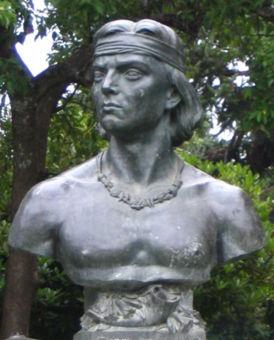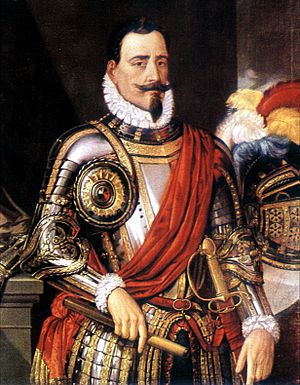Battle of Tucapel facts for kids
Quick facts for kids Battle of Tucapel |
|||||||
|---|---|---|---|---|---|---|---|
| Part of Arauco War | |||||||
|
|||||||
| Belligerents | |||||||
| Commanders and leaders | |||||||
| Strength | |||||||
| 55 Spanish soldiers 2,000–5,000 yanakuna |
more than 50,000 warriors according to Spanish sources, considered exaggerated, modern estimations 10,000 | ||||||
| Casualties and losses | |||||||
| All 55 Spaniards killed most of the yanaconas killed |
Unknown, but not small | ||||||
The Battle of Tucapel was a major fight between Spanish forces and the Mapuche people. It happened on December 25, 1553, near the fort of Tucapel in Chile. This battle was part of the Arauco War, a long conflict where the Mapuche fought against the Spanish trying to take over their lands. The battle was a big defeat for the Spanish. Their leader, Pedro de Valdivia, was captured and later killed.
What Led to the Battle?
The Arauco War was a large conflict in what is now Chile. Pedro de Valdivia was a Spanish conquistador, which means he was a conqueror and explorer. He founded the first Spanish cities in Chile. Around 1550, Valdivia took a young Mapuche man as his servant. This man was baptized as Felipe Lautaro.
Under Valdivia's care, Lautaro quickly learned how to ride horses and use Spanish military tactics. These were skills he would later use against the Spanish. After learning these things, Lautaro returned to his village. He decided to use his new knowledge to help his people fight back.
At the same time, Valdivia was busy building many cities and forts. He spread his Spanish forces across the land he was trying to control. Forts like Tucapel and Purén were built to protect the Spanish.
In December 1553, Valdivia went to check on these forts. He left Concepción and traveled south. Mapuche spies watched his group from the hills. They followed him but did not attack right away. Meanwhile, Lautaro kept a Spanish force trapped in the nearby fort of Purén using clever tricks. Lautaro's spies told him that Valdivia was heading south. He realized Valdivia would likely pass through the fort of Tucapel.
Valdivia became worried because he had no news from Tucapel. He also found it strange that there was no fighting on the road. On December 24, he decided to go straight to the fort. He hoped to find his troops there. The quietness and seeing a few Mapuche in the distance made him even more suspicious. He sent a small group of five scouts ahead to check the road.
The Battle Begins

The Tucapel fort was on a hill near the coast. In December 1553, Mapuche forces, led by Lautaro, attacked and destroyed the fort. They used the battle tactics Lautaro had learned from the Spanish.
Pedro de Valdivia had left Concepción with only 50 soldiers. He sent a message to Purén fort asking for more soldiers. However, Lautaro's men stopped this message.
Valdivia did not hear back from his scouts. He spent the night about half a day's journey from Tucapel. On Christmas Day, December 25, 1553, he left early for the fort. When he arrived, it was completely silent. He found the fort totally destroyed. Neither his other commander nor his scouts were there. He decided to set up camp among the ruins. But as soon as his men started to prepare, shouts came from the forest. Without warning, a large group of Mapuche warriors charged towards the Spanish.
Valdivia was an experienced soldier. He quickly got his men ready to fight. They managed to push back the first Mapuche attack. The Spanish cavalry (soldiers on horseback) chased the retreating Mapuche. But the Mapuche were ready for this. They used long spears called lances to stop the horses. The Spanish fought bravely and pushed the Mapuche back into the forest. The Spanish felt they had won a small victory.
But the fight was not over. A second group of Mapuche attacked. This time, they had clubs called maces and ropes. They used the ropes to pull Spanish horsemen off their horses. Once on the ground, the Spanish soldiers were quickly dragged away. The Spanish managed to push them back again, but many of their men had fallen. Then, a third group of Mapuche appeared, with Lautaro leading them.
Valdivia knew his situation was desperate. Many Spanish soldiers were hurt or tired. Their native allies were also getting fewer. Valdivia saw that the battle was lost. He ordered his men to retreat. But Lautaro moved around their side and trapped the Spanish. The Mapuche killed every Spanish soldier. Only Valdivia and a priest named Pozo, who had the fastest horses, managed to escape. However, they got stuck in a swamp. The Mapuche caught them there.
Valdivia's End
According to some accounts, the Mapuche war chief, Caupolicán, ordered Valdivia's death. One writer, Alonso de Góngora Marmolejo, said Valdivia offered to leave all Spanish settlements in Mapuche lands and give them many animals if they let him go. But the Mapuche refused and killed him and the priest. Another writer, Pedro Mariño de Lobera, also said Valdivia offered to leave their lands. But he wrote that a warrior named Pilmaiquen quickly killed Valdivia with a large club, saying Valdivia could not be trusted. Lobera also mentioned a common story that Valdivia was killed by being given the gold that the Spanish wanted so much. A later legend says Lautaro took Valdivia to the Mapuche camp and killed him after a few days.
After the battle, Caupolicán blocked the city of Valdivia and other Spanish settlements in the south. Lautaro watched the Spanish forces in Concepción, which was the main Spanish center in southern Chile. The Spanish became disorganized because three different men argued over who should be the new governor.
See also
 In Spanish: Batalla de Tucapel para niños
In Spanish: Batalla de Tucapel para niños


